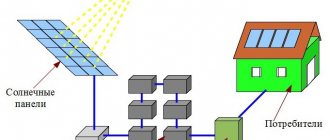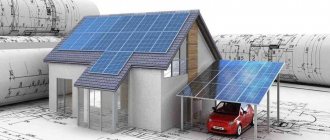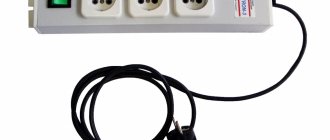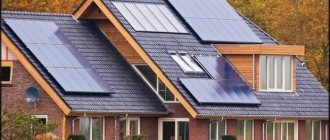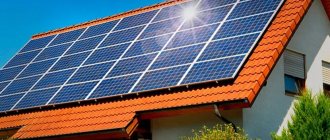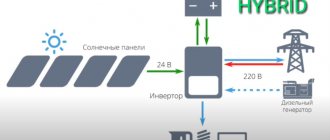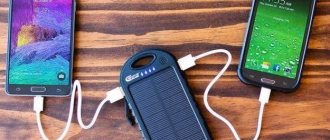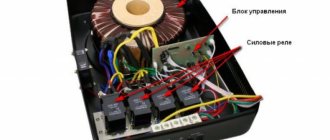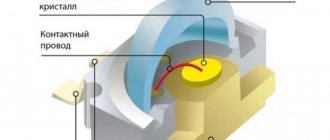An inverter is a device that converts direct current into alternating current with a voltage of 220 V.
The source of direct current for it is both solar and rechargeable batteries. Most often they are used as a backup power supply during power outages in existing power grids.
In general, a solar power installation consists of:
- solar panels;
- inverter;
- battery;
- charge controller;
In order to ensure proper operation of the entire system, the included components must be selected taking into account the technical parameters of each device. This fully applies to inverters operating in conjunction with solar panels.
Solar batteries generate direct current with voltages of 12, 24 and 48 V. It is impossible to directly connect electrical appliances operating from a 220 Volt AC network to solar batteries. Therefore, direct current obtained using solar panels must be converted into alternating current with a voltage of 220 Volts. This is what inverters are for.
Electrical installation diagram:
What is a solar inverter for?
The grid-tied solar inverter is used in full-featured solar systems to convert DC to AC while increasing the voltage. Let's take a closer look at why you need an inverter for solar panels for 12 volts.
The panels convert the energy of sunlight into electric current, which is supplied to the battery through the controller. It accumulates charge and releases it as needed, while simultaneously replenishing the deficiency from solar modules. However, only a few consumer devices can use energy from batteries, since batteries produce low-voltage direct current - 12, 24 or (rarely) 48 V.
A voltage converter for solar panels is needed that can convert these indicators into standard values similar to network values. This task is performed by an inverter for solar panels, which receives 12 (24, 48) V DC from the batteries and supplies the usual 220 V AC to consumers.
The most common are conventional converters, the power of which is in the range of 250-8000 W. The dimensions of such devices depend on the load size, since the power is provided by additional components in the inverter design.
Device Features:
- Efficiency (on average) - 94%, maximum value reaches 99%
- complete absence of radio interference
- stabilized output voltage
- low harmonic distortion
- operating temperature affects quality, so it is necessary to ensure the widest possible range
- presence of overload protection
- losses in idle mode are minimal
- protection from moisture and mechanical damage
The absence of an inverter sharply limits the capabilities of solar panels. They can only charge batteries, provide power for low-voltage lighting or other specific devices. Solar inverters for the home allow you to get maximum efficiency from the panels and provide power for any household technical devices.
It is noteworthy that by connecting three inverters in a cascade, you can obtain a three-phase voltage with standard parameters, which can become a source for powerful electric motors and other installations.
What is included?
The solar installation is formed by:
- solar panel with battery;
- inverter;
- controller.
Inverters are needed to convert direct current into alternating current, since household appliances cannot directly use the energy accumulated by solar panels.
Types of inverters for solar power plants
There are several types of network inverters, differing in some design features and purposes. When assembling a complex of solar panels, various options are used, requiring the owner to correctly understand the specifics and features of their operation. First of all, inverters are distinguished by the shape of the output signal:
- sinusoidal
- rectangular
- pseudosinusoidal
Sinusoidal
The most preferred design option is a sine wave solar inverter . It is capable of producing the highest quality signal shape, optimal for all household appliances, technical and electronic devices.
Rectangular
Square-wave inverters are the cheapest, but they are recommended for use only for simple lighting fixtures. Many types of household appliances cannot operate from such sources.
Pseudo-sinusoidal
Pseudo-sinusoidal devices are a compromise between the first and second types, capable of working with any device. However, it is better not to use them when working with some sensitive types of consumers. In addition, interference and noise may occur from pseudo-sine wave inverters.
In addition, there are inverters designed to operate in different conditions. Let's take a closer look at them:
Network
Network inverters are used when users simultaneously connect to a centralized power supply network. According to the original plan, the inverter provides power to consumers and switches them to network consumption when the battery charge drops below normal.
Typically, grid energy is used during the daytime, when solar batteries are charging. At night there is a transition to autonomous power supply until the battery charge is exhausted. During the daytime, it is possible to release energy to the network if the battery charge is full. This function is also used if the power of solar panels significantly exceeds the needs of the house.
Abroad, there are programs and tariffs where the energy supplied is taken into account and paid to the owner of the solar battery. In our country there are no such opportunities yet, so network inverters for solar power plants are used only to power consumers and switch the energy supply mode.
This type of device is considered the most successful because it works intermittently and has high durability. Its disadvantage is the need to have a parallel connection to a centralized source.
Autonomous
An autonomous solar inverter is a converter that converts battery current into standard alternating voltage. It works in constant mode, there is no external support. Installed between the battery pack and the end consumers of electricity. If an autonomous type inverter fails, the power supply to household technical devices is cut off.
This scheme involves high loads, so the inverter power is selected with a certain margin. In addition, it is necessary to ensure inverter parameters that exceed the starting current of the most powerful consumer. This is important because the peak value can damage the device.
For example, a refrigerator or air conditioner at startup exceeds its operating capacity by 10 times, so it is necessary to have a certain reserve. Before purchasing, you should calculate the total power of all consumers and take into account peak starting loads. In addition, it is necessary to add a margin to compensate for the drop in output power over time.
Hybrid
Hybrid or multifunctional inverters combine in their work all the capabilities of networked and autonomous devices. They are considered the best choice, but their cost often forces users to consider other options.
Solar inverter Sila 3000
One of the most popular devices is the Sila 3000 hybrid solar inverter, reviews of which indicate high performance capabilities. For example, with a rating of 2.4 kW, these inverters are capable of delivering 3 kW for a short time without negative consequences for themselves. When peak startup loads occur, Sila 3000 hybrid solar inverters can withstand operating mode changes. Despite the fact that they are made in China, the durability and reliability of the devices are assessed very positively by users.
Pros and cons of converters with built-in controller
The advantages of the models include:
- possibility of parallel operation in systems with different voltages;
- output voltage control - you can switch between linear and phase;
- quiet operation;
- environmental friendliness - the device does not emit harmful substances during operation;
- ease of installation - built-in charge controller eliminates the need to install another device;
- compactness - the body of most models is no larger than a modern air conditioner.
Among the disadvantages are noted:
- mandatory power supply via an external power supply. If there is no voltage, the converter will not operate solely on the alternative energy source;
- completely discharging the batteries will cause the owner’s entire electrical system to fail;
- failure of a separate controller or converter forces the owner to replace the entire device, which is expensive.
Review of popular models
Let's consider several models of inverters for solar panels, which are considered the highest quality and most reliable:
MAP "Energy"
Products of the Russian MAP "Energia". Several varieties of single- and three-phase devices with a sinusoidal output voltage graph are offered. They have a built-in battery charger. There are different power options from 800 W to 20 kW (withstands a peak short-term load of 25 kW).
Schneider Electric
Schneider Electric, based in France, produces Conext inverters. They can work in difficult conditions, including outdoor installation. The range includes models with a power of 3-20 kW.
TBS Electronics
The Dutch company TBS Electronics offers Poversine sine wave inverters of different powers - from 175 W to 3500 kW. They have multi-stage protection and are able to withstand starting loads tens of times higher than the rated values.
The list of manufacturers of reliable and high-quality inverters can be continued for a long time. The choice of a suitable device must be made based not only on the name of the company, but also on other criteria.
Where is the best place to install the panels?
The first thing you need to do before installing and connecting a solar battery is to decide on the location of the unit.
To install photovoltaic modules, it is convenient to use stationary structures made of metal profiles, or more modernized rotary analogues
Solar panels can be placed in almost any well-lit point:
- on the roof of a country cottage;
- on the balcony of an apartment building;
- in the area adjacent to the house.
The main thing is to provide the necessary conditions for obtaining maximum electricity generation. One of these is the orientation and angle of inclination relative to the horizon. So the light-absorbing surface of the unit should be directed to the south.
Ideally, the sun's rays should fall on it at 90°. To achieve this effect, it is necessary to select the optimal slope angle depending on the climatic conditions of the region. This indicator is different for each region.
To ensure maximum performance of solar panels, it is recommended to change the angle of the devices 2-4 times a year: April 18, August 24, October 7 and March 5
For example, in the Moscow region, the angle of inclination of the surface of solar panels for the summer months is 15-20°, and in the winter months it changes to 60-70°.
Image gallery
Photo from
The most popular place to install solar panels
Positioning on rotating stands
Mounting solar panels on the facade
Solar panels on the attic fence
When placing solar panels in the area adjacent to the house, it is better to raise the panels above the soil surface by at least half a meter - in case a large amount of snow falls. This solution is also correct in the sense that it provides sufficient distance for air circulation.
It is worth remembering that even a small shadow has a detrimental effect on the electricity generation of the unit. Panels should be placed only in places that are not subject to even the slightest shading.
Some “craftsmen” install additional glass on top of the panels to protect the batteries, but even with visible transparency, the glass layer can reduce the efficiency of the panels by 30%
There are several ways to fix the panels:
- by activating the clamping clamps;
- by bolting through through holes located at the bottom of the frame.
The supporting structure must be made of corrosion-resistant materials. Regardless of the installation method, you cannot make changes to the panel design yourself or drill additional holes.
It is the homeowner's job to keep the panels clean. Collecting dust, snow and bird droppings on the screen will reduce the amount of electricity produced by the system by at least 10%.
Inverter selection
Let's look at how to choose a grid-connected solar inverter. The best option is to purchase a ready-made set of devices with selected parameters. Selecting a separate inverter is a task that is quite difficult for an untrained person. However, you often have to buy a device for a ready-made set of solar modules.
It is customary to be guided by the following indicators:
- input voltage and power matching
- methods of protection
- Operating temperature range
- presence of several modes
- Efficiency
When choosing network inverters for solar panels, you need to make a simple calculation. The power of all consumers is added up, and some reserve is added to ensure peak loads.
It must be borne in mind that many consumers create an increased starting load at the time of startup. If the inverter power is selected incorrectly, peak values will quickly damage the device. In addition, you need to pay attention to the permissible temperature values, since the inverter is sensitive to this indicator.
Types differing in output voltage
Devices are divided according to this criterion into meander and sinusoidal. The voltage of the former at the output practically coincides with the power supply, which guarantees the safety of highly sensitive equipment
The output signal is a sine wave. For operating equipment, it is considered best if it is ideal. This is very important especially for telecommunication devices, high-frequency measuring instruments, and medical equipment. Even taking into account the high cost of these complex inverters, there are no other options for them. Therefore, such a serious parameter is indicated by manufacturers in the specifications.
For the second - non-sinusoidal inverters, the output pulse looks like a rectangle - a modified (quasi) sine.
Such inverters are not recommended for use where the load is single. But they are quite suitable for the active component of power.
Ideal sine wave inverters are large and expensive.
Quasi-sinusoidal ones, which produce a signal in a triangular shape, in the form of a trapezoid and a rectangle, are in greater demand, which is explained by their smaller size and cost.
Connecting the inverter to the solar battery
It is necessary to prepare a cable of the appropriate cross-section that can withstand all possible loads. It is necessary to take into account that the length of the connecting cable between the solar panels and the inverter should not exceed 3 m. If consumers are located far from the modules, extend the high-voltage arm - a 220 V cable. Consider the procedure for connecting the device to a set of solar equipment:
Scheme
The simplest diagram for connecting an inverter is in the gap between consumers and batteries. This option is used for standalone devices.
The most complex scheme is for networked or hybrid devices. In parallel with the battery, the mains voltage is connected (to the corresponding contacts), and the load is immediately connected. An additional pair of contacts is intended for a redundant system (backup lighting, emergency power, etc.). The choice of circuit depends on the purpose and design of the inverter, as well as the availability of a connection to a centralized network.
Stages
The process of connecting devices does not cause any difficulties. All contacts are named, the main task is not to confuse them in a hurry. First, the entire kit is assembled - panels, controller, battery. After this, connect the inverter and check its functionality. Any errors found are immediately corrected. When you are completely confident that all connections are correct, connect the payload - power supplies. From this moment on, the solar panels are considered to be put into operation.
Bonus - instructions
I printed out these instructions for the home owner:
BRIEF INSTRUCTIONS The system receives electricity from the street network and from solar panels, accumulates it in batteries, and converts it through inverters into 220V alternating voltage. In the normal state, the position of the switch is at the top, operation occurs through inverters. If there is a problem with the operation of the inverters, it is necessary to turn off the load using the automatic switches in the bottom row in the old switchboard, and move the switch up through the middle position. Then turn on all the machines. After this, the system will be powered only from the street network. When troubleshooting inverters, also turn off the load and switch the switch to the lower position, then turn on all the machines. An intermittent beep from inverters usually indicates an overload. In this case, it is necessary to reduce the load by turning off the least necessary electrical appliances. Also, if possible, view the error message and the output power of the inverters.
